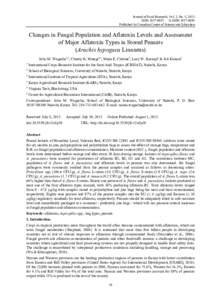| dc.contributor.author | Wagacha, M. |
| dc.contributor.author | Mutegi, C. |
| dc.contributor.author | Christie, M.E. |
| dc.contributor.author | Karanja, L.W. |
| dc.contributor.author | Kimani, J. |
| dc.date.accessioned | 2019-12-04T11:03:54Z |
| dc.date.available | 2019-12-04T11:03:54Z |
| dc.date.issued | 2013 |
| dc.identifier.citation | Wagacha, J., Mutegi, C., Christie, M.E., Karanja, L.W., & Kimani, J. (2013). Changes in fungal population and aflatoxin levels and assessment of major aflatoxin types in stored peanuts (Arachis hypogaea Linnaeus). Journal of Food Research, 2(5), 10-23. |
| dc.identifier.issn | 1927-0887 |
| dc.identifier.uri | https://hdl.handle.net/20.500.12478/1277 |
| dc.description.abstract | Peanut kernels of Homabay Local, Valencia Red, ICGV-SM 12991 and ICGV-SM 99568 cultivars were storedfor six months in jute, polypropylene and polyethylene bags to assess the effect of storage bags, temperature andR.H. on fungal population and aflatoxin contamination. Moisture content (M.C.), fungal population and aflatoxinlevels were determined before storage and after every 30 days during storage. Isolates of Aspergillus flavus andA. parasiticus were assayed for production of aflatoxin B1, B2, G1 and G2. The correlation between MC,population of A. flavus and A. parasiticus and aflatoxin levels in peanuts was also determined. Six fungalpathogens were commonly isolated from the peanut samples and occurred as follows in decreasing order:Penicillium spp. (106.6 CFU/g), A. flavus L-strain (4.8 CFU/g), A. flavus S-strain (2.9 CFU/g), A. niger (2.6CFU/g), A. parasiticus (1.7 CFU/g) and A. tamarii (0.2 CFU/g). The overall population of A. flavus L-strain was66% higher than that of A. flavus S-strain. Ninety one percent of A. flavus and A. parasiticus isolates produced atleast one of the four aflatoxin types assayed, with 36% producing aflatoxin B1. Total aflatoxin levels rangedfrom 0 - 47.8 μg/kg with samples stored in polyethylene and jute bags being the most and least contaminated,respectively. Eighty nine percent and 97% of the peanut samples met the EU (≤ 4 μg/kg) and Kenyan (≤ 10μg/kg) regulatory standards for total aflatoxin, respectively. Peanuts should be adequately dried to safe moisturelevel and immediately packaged in a container - preferably jute bags - which will not promote critical increasesin fungal population and aflatoxin contamination. |
| dc.format.extent | 10-23. |
| dc.language.iso | en |
| dc.subject | Aflatoxins |
| dc.subject | Aspergillus Flavus |
| dc.subject | Peanuts |
| dc.title | Changes in fungal population and aflatoxin levels and assessment of major aflatoxin types in stored peanuts (Arachis hypogaea Linnaeus) |
| dc.type | Journal Article |
| dc.description.version | Peer Review |
| cg.contributor.crp | Grain Legumes |
| cg.contributor.affiliation | International Crops Research Institute for the Semi-Arid Tropics |
| cg.contributor.affiliation | University of Nairobi |
| cg.contributor.affiliation | International Institute of Tropical Agriculture |
| cg.contributor.affiliation | Kenya Agricultural Research Institute |
| cg.contributor.affiliation | Virginia Polytechnic Institute and State University |
| cg.contributor.affiliation | CAB International |
| cg.coverage.region | Africa |
| cg.coverage.region | East Africa |
| cg.coverage.country | Kenya |
| cg.authorship.types | CGIAR and developing country institute |
| cg.iitasubject | Aflatoxin |
| cg.iitasubject | Grain Legumes |
| cg.journal | Journal of Food Research |
| cg.howpublished | Formally Published |
| cg.accessibilitystatus | Open Access |
| local.dspaceid | 78680 |
| cg.identifier.doi | https://dx.doi.org/10.5539/jfr.v2n5p10 |

